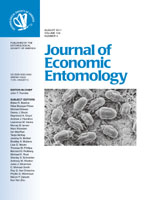The majority of plant viruses are dependent on arthropod vectors for spread between plants. Wheat streak mosaic virus (family Potyviridae, genus Tritimovirus, WSMV) is transmitted by the wheat curl mite, Aceria tosichella Keifer, and this virus and vector cause extensive yield losses in most major wheat (Triticum aestivum L.)-growing regions of the world. Many cultivars in use are susceptible to this vector-virus complex, and yield losses of 10–99% have been documented, wheat curl mite resistance genes have been identified in goat grass, Aegilops tauschii (Coss) Schmal., and transferred to hexaploid wheat, but very few varieties contain effectively wheat curl mite resistance, due to virulent wheat curl mite populations. However, wheat curl mite resistance remains an effective strategy to reduce losses due to WSMV. The goal of our project was to identify the most effective, reproducible, and rapid method for assessing wheat curl mite resistance. We also wanted to determine whether mite resistance is affected by WSMV infection, because the pathogen and pest commonly occur together. Single and group wheat curl mite infestations produced similar amounts of leaf rolling and folding on wheat curl mite-susceptible wheat varieties that were independent of initial wheat curl mite infestation. This finding will allow accurate, efficient, large-scale screening of wheat germplasm for wheat curl mite resistance by infesting plants with sections of wheat leaf tissue containing mixed stages of wheat curl mite. The wheat curl mite-resistant breeding line ‘OK05312’ displayed antibiosis (reduced wheat curl mite population development). The effect of WSMV infection on wheat curl mite reproduction was genotype-dependent. Mite populations increased on infected wheat curl mite- and WSMV-susceptible plants compared with uninfected plants, but WSMV infection had no significant effect on wheat curl mite populations on resistant plants. OK05312 is a strong source of wheat curl mite resistance for wheat breeding programs.
BioOne.org will be down briefly for maintenance on 17 December 2024 between 18:00-22:00 Pacific Time US. We apologize for any inconvenience.
How to translate text using browser tools
1 August 2011
Wheat Curl Mite Resistance: Interactions of Mite Feeding with Wheat Streak Mosaic Virus Infection
M. Murugan,
P. Sotelo Cardona,
P. Duraimurugan,
A. E. Whitfield,
D. Schneweis,
S. Starkey,
C. M. Smith
ACCESS THE FULL ARTICLE
It is not available for individual sale.
This article is only available to subscribers.
It is not available for individual sale.
It is not available for individual sale.

Journal of Economic Entomology
Vol. 104 • No. 4
August 2011
Vol. 104 • No. 4
August 2011
interaction
resistance
wheat
wheat curl mite
Wheat streak mosaic virus




